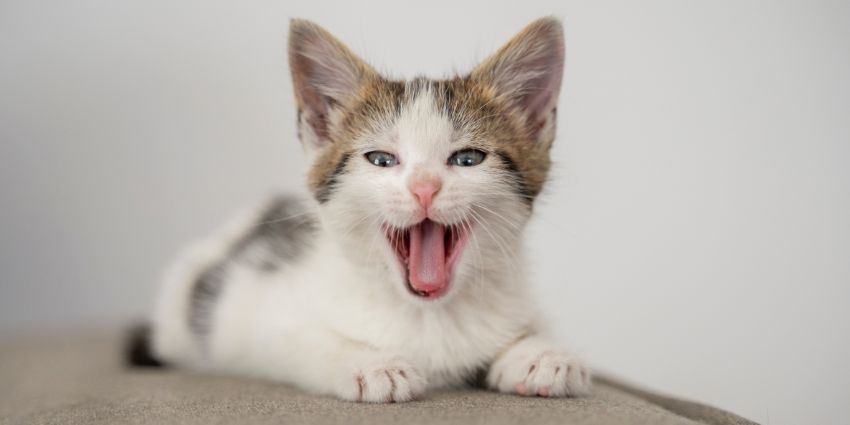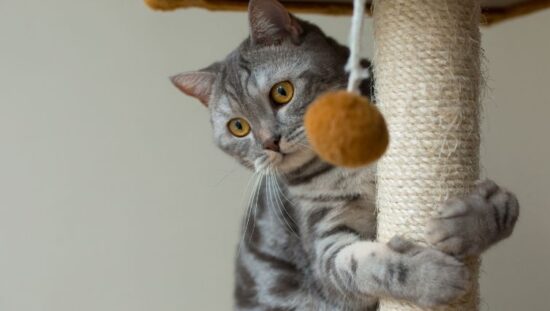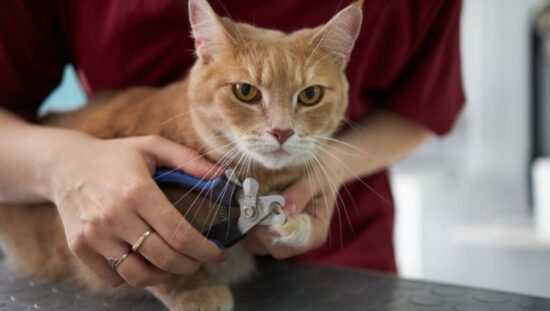Did you ever wonder what your cat is trying to say with its different sounds? Cats use a variety of vocalizations to show their feelings and needs.
Understanding these sounds can help you connect better with them. In this simple guide, we’ll explain what your cat’s meows, purrs, hisses, and other noises mean. Let’s get started!

Common Cat Sounds and Their Meanings
Cats communicate with us through various sounds, each with a different meaning. Understanding these common cat sounds can help you respond to your cat’s needs more effectively and make your bond stronger. Whether your cat is meowing for attention, purring because they’re happy, or hissing when they’re upset, understanding these sounds is important for a good relationship with your cat. Keep reading to learn more about the different sounds cats make and how you can better understand your furry friend!
1. Meowing
Meowing is the main way cats talk to humans. They use meows to tell us when they’re hungry, want attention, or feel uncomfortable. The way a cat meows can tell you a lot about what they need. For example, a high-pitched meow usually means your cat is happy to see you or saying hello. On the other hand, a low-pitched meow often means they are upset or complaining about something. By listening to the pitch and frequency of your cat’s meows, you can better understand what they are trying to say.
Additionally, if you’re experiencing issues with your cat meowing excessively at night, check out our blog on Understanding and Solving Cat Meowing at Night for helpful tips on addressing this common behavior.
2. Purring
Purring is a common sound that usually means your cat is happy and relaxed. When your cat purrs while sitting on your lap or being petted, it’s a sign they feel happy and comfortable. However, purring can also occur when a cat is in pain or anxious. In these cases, they purr to comfort themselves. So, even though purring often means that your cat is pleased, it’s important to pay attention to the context to understand how they really feel.
3. Hissing
Hissing is a sound cats make when they are scared, threatened, or uncomfortable. When a cat hisses, it means they want to be left alone. You might see other signs like an arched back, flattened ears, and puffed-up fur. These signals show that your cat feels defensive and is trying to protect itself. If your cat is hissing, it’s best to give them some space until they feel safe again.
4. Growling
Growling is a warning sound that cats use to scare away threats. When a cat growls, it’s telling you or another animal to stay away. This sound usually comes with other defensive actions, like swishing tails and showing teeth. Growling is a sign that your cat feels threatened and is ready to defend itself if necessary. If you hear your cat growling, give them space and avoid upsetting them more.
5. Chirping and Chattering
Chirping and chattering are sounds that cats make when they see something they want to catch, like a bird or a bug, but they can’t reach it. It’s like they’re saying, “I want that!” These sounds show that your cat is excited and maybe a little frustrated that they can’t get to their prey. You can see your cat making these noises when they’re looking out the window at birds or insects. Chirping and chattering are natural behaviors for cats and are nothing to worry about. It’s just your cat showing their hunting instincts!
6. Yowling
Yowling is a long, moaning sound that cats make for different reasons. Sometimes, cats yowl to find a mate. Other times, they use it to mark their territory or show they’re upset. You might hear your cat yowling if they’re in pain or upset. It’s like they’re saying, “I need help!” Yowling is a way for cats to communicate their feelings, whether it’s about love, territory, or discomfort. If your cat is yowling a lot, it’s a good idea to check if everything is okay with them.
7. Trilling
Trilling is a friendly sound that cats make to say hello or get your attention. It’s like they’re saying, “Hi there!” or “Pay attention to me!” Cats often use trilling to communicate with their owners or other cats happily. You can hear your cat trilling when they see you after being apart or when they want to play. Trilling is a positive sound that shows your cat likes you and wants to play with you. So, if your cat trills at you, feel special—they’re happy to see you!
8. Caterwauling
Caterwauling is a loud and distressing sound that cats make when they’re in heat or feeling really uncomfortable. It’s like they’re calling out for something they need desperately. Cats use caterwauling to attract mates or to show they’re upset, especially during territorial fights. You might hear this noise if there are stray cats around your home or if your own cat is feeling very uncomfortable. Caterwauling can be intense and unsettling, but it’s just your cat showing their strong feelings.
When to Seek Veterinary Advice
Knowing when to seek veterinary advice for your cat is important to keep them healthy and happy. Here are some signs to watch out for:
- Changes in Eating or Drinking: If your cat suddenly stops eating or drinking, or if they’re eating or drinking a lot more than usual, it could be a sign of a health problem.
- Lethargy or Weakness: If your cat seems unusually tired, weak, or unwilling to move, it might mean they’re not feeling well.
- Vomiting or Diarrhea: Occasional vomiting or diarrhea might not be a big concern, but if it keeps happening a lot or is really bad, it could mean something more serious is going on.
- Difficulty Breathing: Wheezing, coughing, or having a hard time breathing are signs that your cat might have a breathing problem that needs help.
- Changes in Behavior: If your cat starts acting differently than usual, such as hiding more than usual, being really vocal, or showing aggression, it could mean they’re not feeling well.
- Unexplained Weight Loss or Gain: Big changes in your cat’s weight without a clear reason could mean there’s a health problem going on.
- Visible Signs of Pain: If your cat is limping, favoring one side, or showing signs of discomfort when touched, they might be in pain and need medical attention.
If you see any of these signs in your cat, it’s a good idea to talk to your vet for advice. They can see if your cat needs more checks or treatment to stay healthy and happy.
Conclusion
Knowing when to ask the vet for help with your cat is very important. If you see changes in how your cat acts, eats, or feels, it’s a good idea to talk to the vet. They can figure out what’s going on and help your cat feel better. Remember, your vet is there to help both you and your cat, so don’t be afraid to call them if something seems wrong. That way, you can make sure your cat stays healthy and happy for a long time.



